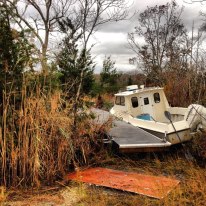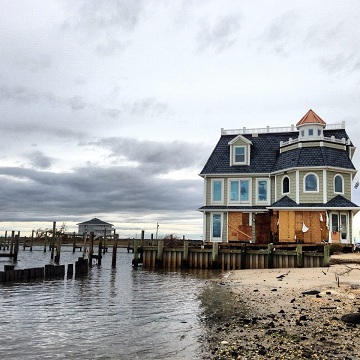Timing and framing: How to address nuclear and climate change
Technology is an amazing thing. As Hurricane Sandy approached the Northeast last month, I watched and read as friends in the area tweeted pictures and thoughts on the situation. I didn't have to worry if they were okay, as many were able to post hourly status updates with items such as: "Still okay, still have power. Just wish we had more beer and chocolate."
In stark contrast to the several-day silence in the wake of Katrina in 2005, New Yorkers were ready with carefully-charged mobile devices that allowed them to self-report their entire experience of Sandy-even long after the power was out. In 2005, the iPhone and Twitter did not yet exist. Seven years later, these tools were essential in New York City's emergency response.
New York's Governor Cuomo
In the wake of the storm I also bore witness to New York Governor Andrew Cuomo's real-time "climate awakening" on twitter. Yes, I know it sounds strange, but he shared his realization that climate change is here now, 140 characters at a time over the Internet. He also made the rounds with the media, refusing to entertain a political debate about the causes of climate change, and instead focused on the immediate challenge of managing increased coastal flooding of his state in recent years. Having just witnessed the first presidential debate in my lifetime that did not focus on climate change as a central issue-I was relieved that a politician was willing to talk climate with both frankness and urgency.
Unfortunately, Cuomo also used this as an opportunity to talk about shutting down Indian Point Nuclear Station-one of the structures and sources of electricity that weathered the storm without damage. He sees the changing climate as a threat to one of New York's primary energy suppliers, and thinks it should be shuttered.
Timing and framing
Two things about this situation struck me as important: timing and framing.
The framework that Cuomo has laid out is extremely important in that it serves to confirm what some people already believe should happen, at a time when they expect dramatic action. That confluence of events translates into a real risk of shutting down nuclear plants specifically in response to climate change, now and in the future. If the nuclear industry stays mum on climate change, this could become a dominant narrative.
The iron is hot, however, for providing another way of framing the situation that offers a better solution.
Repositioning and reframing
 In my opinion, the nuclear industry has a critical opportunity at this point in history to position itself as the hero in this story. First of all, nuclear is one of the largest sources of carbon-free electricity. Anyone who is serious about addressing climate change needs to be fully aware of the many, many historical and current examples of increased greenhouse gas emissions as an unavoidable outcome of shutting nuclear plants. In addition to increased emissions, Germany and Japan are also dealing with skyrocketing energy prices and grid destabilization that is negatively impacting manufacturing.
In my opinion, the nuclear industry has a critical opportunity at this point in history to position itself as the hero in this story. First of all, nuclear is one of the largest sources of carbon-free electricity. Anyone who is serious about addressing climate change needs to be fully aware of the many, many historical and current examples of increased greenhouse gas emissions as an unavoidable outcome of shutting nuclear plants. In addition to increased emissions, Germany and Japan are also dealing with skyrocketing energy prices and grid destabilization that is negatively impacting manufacturing.
The nuclear industry is also very experienced and knowledgeable in terms of hardening infrastructure and emergency preparedness. So, as Cuomo fights for better infrastructure and planning in the face of climate change, he has mistaken a potential ally-the nuclear industry-as a foe. The nuclear industry can help reduce impacts of climate change by building out new nuclear technologies, and also by providing an advanced understanding of adapting and preparing for extreme weather.
As small modular reactors and Generation IV designs near commercialization, we need to update the way we frame and communicate about the role of nuclear energy in society. In the 1950s, radiation gave comic heroes their superpowers Now, nuclear is often aligned with the villains in movies and comics. Luckily, we live in a time when information abounds and perspectives and cultural constructs change rapidly, and everyday people have more power than ever to influence that dialogue.
Technology and the subsequent ways that we communicate are constantly evolving. Just a few short years ago there was no such thing as Twitter, and social media was just starting to gain traction as a serious platform for news and information. Now, social media is central to how we share information and communicate-and even to how we conduct emergency response.
Nuclear is a relatively new technology when compared to other energy sources (younger even than solar and wind), and we are still adapting and processing our feelings about this technology as a culture. The dominant narrative at this time is that people who are concerned about climate change should reject nuclear energy-but that simply does not have to be the case. Right now is the perfect time to provide a new framework for supporting nuclear as a solution to climate change.
I highly recommend starting with Governor Cuomo. If you'd like to tweet your thoughts to him, his Twitter handle is @NYGovCuomo-let him know that the nuclear industry is the hero in this story-not the villain.
Photos courtesy of Greg Molyneux
_______________________________________

Hobbs Baker
Suzy Hobbs Baker is the executive director of PopAtomic Studios, a nonprofit organization that conducts educational outreach through the Nuclear Literacy Project. Baker is an ANS member and a frequent contributor to ANS Nuclear Cafe.









